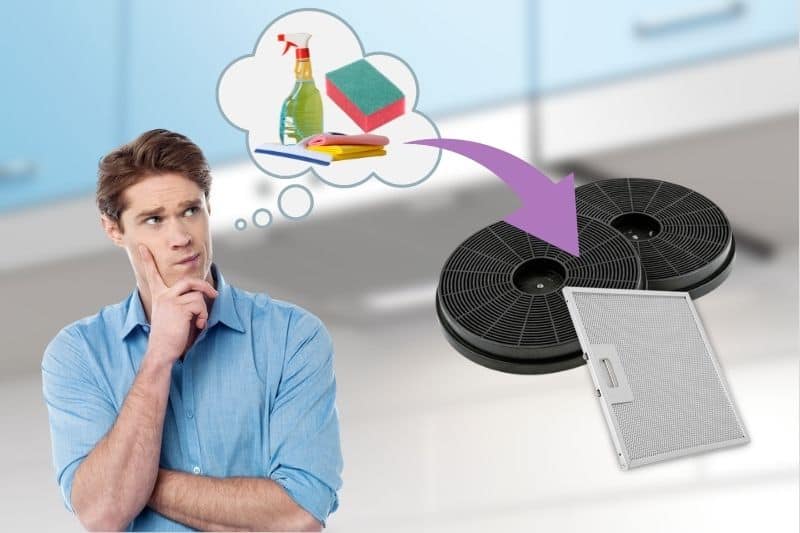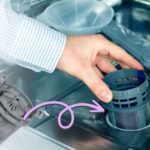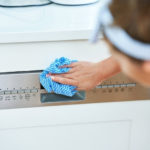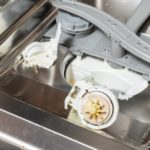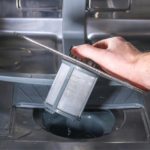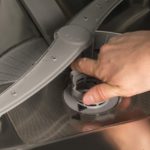The unseen saviours of your cooker hood, your cooker hood filters trap grease and odours caused by cooking.
Without these filters, your kitchen would perpetually smell like a greasy fry-up, so it’s important to keep them in working order.
There are two types of cooker hood filters – grease filters should be used with all cooker hoods, whereas recirculation cooker hoods also use carbon filters.
Your grease filter can be washed by hand with degreasing soap, or in the dishwasher at a high temperature, but a carbon filter must be replaced.
I’ll tell you more about maintaining each type of cooker hood filter in the rest of this article, alongside explaining the need for each filter.
Plus, I’ll provide detailed cleaning methods for your cooker hood’s grease filter. Let’s replace cooking grease with elbow grease!
What’s the Difference Between Carbon and Grease Filters?
Before learning about how to maintain your cooker hood filters, you should learn what they are.
A recirculation cooker hood should have two filters working in tandem – a carbon or charcoal filter and a separate grease filter made from metal, ceramic, fabric, or paper. An extraction fan cooker hood only needs a grease filter.
Carbon Filters

The carbon filter sits above the grease filter, and its purpose is to filter odours, smoke, steam, and any grease the other filter doesn’t catch. This filter is usually made with activated charcoal, which absorbs oil and other particles from the air.
A carbon filter is only necessary with a recirculation cooker hood, which filters polluted air and then vents it back into your kitchen.
Conversely, an extraction fan cooker hood doesn’t need to completely purify the air, since it vents polluted air outside through a duct. Therefore, an extraction fan cooker hood doesn’t need a carbon filter.
Can you clean carbon filters?
Activated carbon is used as a filter because it’s packed tight with tiny pores which can absorb the maximum number of oil and dirt particles. Submerging carbon in water will damage its structure, rendering it ineffective.
You can’t clean standard cooker hood carbon filters, so your carbon filter will need to be replaced once it gets too dirty.
You can lessen the number of carbon filter replacements required by regularly cleaning your grease filter, to trap most of the dirt before it reaches your carbon filter.
Long-life carbon filters can typically be rinsed and ‘restored’ up to five times before they need to be replaced, but these filters are rare.
Replacing carbon filters
You’ll need to ensure that your carbon filter replacement is suitable for your brand of the cooker hood. Some filters won’t fit correctly or won’t be optimal for your hood. Most carbon filter replacements cost around £14, but this varies.
How to replace carbon filters
Replacing a carbon filter doesn’t require any complex instructions, but it might differ slightly depending on the model of your cooker hood.
You can remove a carbon filter by first removing the grease filter and finding the carbon filter behind it. Then, you should be able to slide the carbon filter out.
Some models will have a mechanism that releases the filter. For example, Hotpoint models might require you to grasp the carbon filter and rotate it clockwise until it releases.
You can slot your new carbon filter into the position of the old one. If you’re having trouble with replacing your carbon filter, consult your cooker hood’s manual or contact its manufacturer for help.
How often should you replace carbon filters?
Carbon filters need to be replaced roughly every 3 to 4 months, but it depends on your usage and brand of cooker hood. Check-in with your cooker hood’s manufacturer for specific advice on how often to replace your carbon filter and see if they also offer parts.
Grease Filters
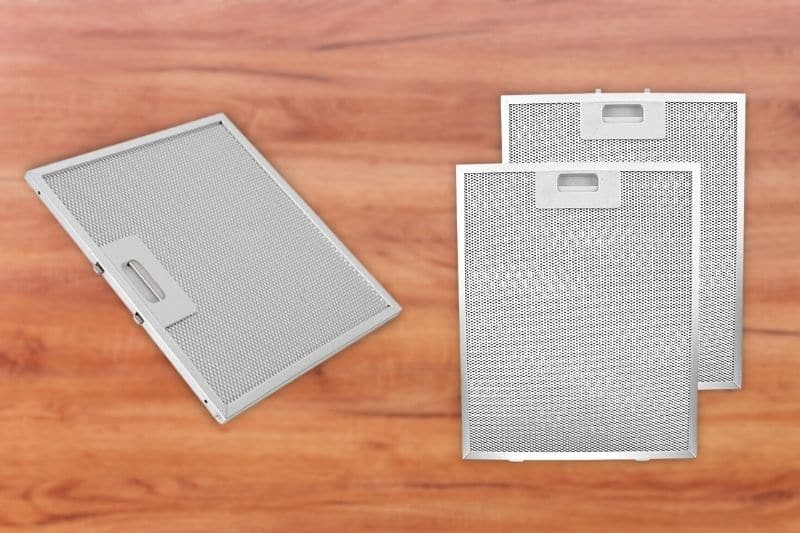
Your cooker hood’s grease filter is designed to trap the oil particles within the steam produced by cooking with the hob or oven. This is to avoid coating the inside of your cooker hood with grease and to prolong the life of your carbon filter if you need one.
A grease filter will typically be made from a metal like aluminium or steel. It may also be made from fabric, ceramic, paper, or a blend of materials like cellulose and viscose.
Can you clean grease filters?
I recommend purchasing a reusable grease filter, such as one made from aluminium. If you buy and maintain a metal grease filter, you’ll never need to replace it.
Metal and ceramic grease filters can easily be cleaned, whilst fabric and paper ones will need to be replaced.
You can get away with shoving your reusable grease filter in the dishwasher, but it may need hand-washed if it’s especially dirty. I’ll cover both methods in this guide!
Removing grease filters
Your cooker hood will come with instructions detailing how to remove your grease filter, but it should be simple to figure out otherwise.
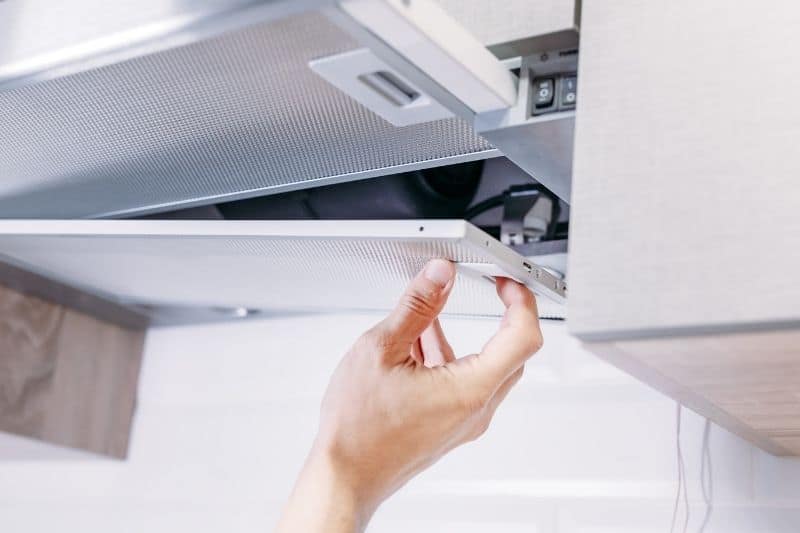
You should be able to simply pry the grease filter off using your fingers, but there may be a clasp or other mechanism holding it in place. Contact your cooker hood manufacturer if you’re stumped.
Cleaning grease filters in the dishwasher
If you’re washing your grease filter in the dishwasher, it should be the only item in there! Otherwise, food particles from dirty dishes will get trapped in your grease filter.
Use a high temperature of at least 65C and a powerful dishwasher tablet to dissolve grease from your filter. Ensure the filter is completely dry before reinserting it onto your cooker hood.
Cleaning grease filters by hand
If your grease filter is particularly dirty, it might need more care and attention than the dishwasher can provide.
You can clean a grease-coated filter by hand using warm water, washing-up liquid, and bicarbonate of soda. You should also have a non-abrasive brush, like this natural bamboo dish brush, to scrub your filter without damaging it.
First, choose a sink or basin large enough to hold the filter, and fill it with hot water.
Then, mix in a generous squirt of washing-up liquid and three tablespoons of bicarbonate of soda.
Let your grease filter soak for fifteen minutes, before using your brush to scrub the filter gently and carefully, removing all the caked-on grease and filth.
Lastly, rinse off the filter with hot water and dry it with a clean cloth. You can also leave the filter to dry naturally before fixing it to your cooker hood again.
How often should you clean grease filters?
You should clean your grease filter every 4-8 weeks, depending on how frequently you use your cooker hood.
If you’ve got a fabric or paper filter, you should probably be replacing it monthly, but it also depends on the frequency of your cooking.
Conclusion
Your cooker hood’s grease filter traps grease from cooking before it contaminates your cooker hood. A recirculation cooker hood will also have a carbon filter above the grease filter, but a carbon filter isn’t necessary with an extraction fan cooker hood.
Re-usable cooker hood grease filters made from metal or ceramic can be both hands washed and run through the dishwasher. These filters should be washed every 4-8 weeks to prevent grease build-up.
However, carbon filters and paper or fabric grease filters can’t be cleaned and will instead need to be replaced once they get too dirty.

A recent uni graduate who likes writing, gaming, and drawing. I’m figuring out housekeeping tips alongside you while trying to provide eco-friendly cleaning options. Let’s find out how to use a tumble dryer together!
